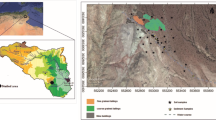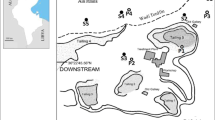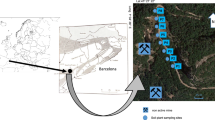Abstract
Purpose
Hazardous waste deposits with high contents of risk elements can represent a potential environmental hazard via penetration of these elements into soil and vegetation. In this case, the former deposit of galvanic sludges in Dolní Lipka, Czech Republic, was investigated. The deposit was temporarily remediated by a thick soil layer cover. The total and mobile risk element contents were determined within the profile of the soil cover as well as the element contents in the vegetation growing on the cover to assess the potential environmental threat of the deposit
Materials and methods
The plant samples were collected from nine sampling areas, each of 3 × 3 m. The stratification of risk elements within the soil profile was determined where the soil samples were collected in depths of 0–10, 10–40, 40–70, 70–100, and 100–140 cm. The total element contents were determined in aboveground biomass and roots of selected plant species and pseudo total content (extractable with aqua regia) in soils. The mobilizable pool of elements in soils was determined after extraction with a 2 mol L−1 solution of HNO3 and a plant-available pool of elements after extraction with 0.11 mol L−1 solution of CH3COOH.
Results and discussion
From the perspective of the vegetation and soil’s risk elements content, the dump did not meet criteria for a safe hazardous waste landfill in any way during the sampling time. According to the results, the elements can be divided into three groups: (i) low levels of elements within whole profile—As and Cr; (ii) high levels of elements concentrated in the deepest layer of the soil without significant penetration of the upper layers—Cu, Mo, Pb, Ni, and Zn; and (iii) the elements penetrating the upper layers of the soil—Cd and Hg.
Conclusions
The third case poses a serious environmental risk requiring more intensive investigation on the bioavailability of these elements at the site, and subsequently, permanent remediation of the deposit.









Similar content being viewed by others
References
Ali SM, Pervaiz A, Afzal B, Hamid N, Yasmin A (2014) Open dumping of municipal solid waste and its hazardous impacts on soil and vegetation diversity at waste dumping sites of Islamabad city. Journal of King Saud University - Science 26:59–65
Anonymous (1994a) Council Directive 94/31/EC of 27 June 1994 amending Directive 91/689/EEC on hazardous waste
Anonymous (1994b) Public notice No. 13/1994, regulating some details concerning the preservation of agricultural lands available. Czech Ministry of the Environment, Prague
Anonymous (1999) Council Directive 1999/31/EC of 26 April 1999 on the landfill of waste
Anonymous (2001) Law No. 185/2001 Sb: Waste management law. Legal code of The Czech Republic
Anonymous (2002) Directive No. 2002/32/ES of European Parliament and Council of Europe concerning xenobiotics in feedstuffs
Bahaa-eldin EAR, Yusoff I, Abdul Rahim S, Zuhairi WYW, Ghani MRA (2011) Tracing subsurface migration of contaminants from an abandoned municipal landfill. Environ Earth Sci 63:1043–1055
Baroni F, Boscagli A, DiLella LA, Protano G, Riccobono F (2004) Arsenic in soil and vegetation of contaminated areas in southern Tuscany (Italy). J Geochem Explor 81:1–14
Borůvka L, Huanwei C, Kozák J, Krištoufková S (1996) Heavy contamination of soil with cadmium, lead and zinc in the alluvium of the Litavka river. Rostl Výr 42:543–550
Bouazza A (1997) Performance of geosynthetic clay liners. Environ Geotech 307–313
Dolk H, Vrijheid M, Armstrong B, Abramsky L, Bianchi F, Garne E, Nelen V, Robert E, Scott J, Stone D, Tenconi R (1998) Risk of congenital anomalies near hazardous-waste landfill sites in Europe: the EUROHAZCON study. Lancet 352:423–427
Evans JC (2002) Slurry walls for the rehabilitation of land disposal sites. In: Almorza D, Brebbia CA, Sales D, Popov V (eds) Waste Management and the Environment, pp. 421–430, Wessex Inst Technol; Univ Cadiz, Cadiz
Felix F, Fraaij ALA, Hendriks CF (2003) Evaluation of a decision support system for the useful application of hazardous wastes with means of immobilisation-techniques. Mater Struct 36:599–603
Fergusson JE (1990) The heavy elements: chemistry, environmental impact, and health effects. Pergamon Press, Oxford
Franco-Hernández MO, Vásquez-Murrieta MS, Patiño-Siciliano A, Dendooven L (2010) Heavy metals concentration in plants growing on mine tailings in Central Mexico. Biores Technol 101:3864–3869
Hu Y, Liu X, Bai J, Shih K, Zeng EY, Cheng H (2013) Assessing heavy metal pollution in the surface soils of a region that had undergone three decades of intense industrialization and urbanization. Environ Sci Pollut Res 20:6150–6159
Jain P, Kim H, Townsend TG (2005) Heavy metal content in soil reclaimed from a municipal solid waste landfill. Waste Manag 25:25–35
Kabata-Pendias A, Pendias H (2001) Trace elements in soils and plants, 3rd edn. CRC press, Boca Raton
Kasassi A, Rakimbei P, Karagiannidis A, Zabaniotou A, Tsiouvaras K, Nastis A, Tzafeiropoulou K (2008) Soil contamination by heavy metals: measurements from a closed unlined landfill. Biores Technol 99:8578–8584
Kim KR, Owens G (2010) Potential for enhanced phytoremediation of landfills using biosolids—a review. J Environ Manag 91:791–797
Kogbara RB (2014) A review of the mechanical and leaching performance of stabilized/ solidified contaminated soils. Environ Rev 22:66–86
Li Y, Li J, Chen S, Diao W (2012) Establishing indices for groundwater contamination risk assessment in the vicinity of hazardous waste landfills in China. Environ Pollut 165:77–90
Linde M, Öborn I, Gustafsson JP (2007) Effects of changed soil conditions on the mobility of trace metals in moderately contaminated urban soils. Water Air Soil Pollut 183:69–83
Madrid F, Lopez R, Cabrera F (2007) Metal accumulation in soil after application of municipal solid waste compost under intensive farming conditions. Agric Ecosyst Environ 119:249–256
Matache M, Rozylowicz L, Ropota M, Patroescu C (2003) Heavy metals contamination of soils surrounding waste deposits in Romania. J Phys IV 107:851–854
Matejczyk M, Płaza GA, Nałeçz-Jawecki G, Ulfig K, Markowska-Szczupak A (2011) Estimation of the environmental risk posed by landfills using chemical, microbiological and ecotoxicological testing of leachates. Chemosphere 82:1017–1023
Mishra B, O’Loughlin EJ, Boyanov MI, Kemner KM (2011) Binding of Hg-II to high-affinity sites on bacteria inhibits reduction to Hg-0 by mixed Fe-II/III phases. Environ Sci Technol 45:9597–9603
Morselli L, Passarini F, Bartoli M (2002) The environmental fate of heavy metals arising from a MSW incineration plant. Waste Manag 22:875–881
Moturi MCZ, Rawa M, Subramanian V (2004) Distribution and fractionation of heavy metals in solid waste from selected sites in the industrial belt of Delhi, India. Environ Monit Assess 95:183–199
Mwiganga M, Kansiime F (2005) The impact of Mpererwe landfill in Kampala–Uganda, on the surrounding environment. Phys Chem Earth 30:744–750
Nagendran R, Selvam A, Joseph K, Chiemchaisri C (2006) Phytoremediation and rehabilitation of municipal solid waste landfills and dumpsites: a brief review. Waste Manag 26:1357–1369
Nauska J, Vaittinen M (2000) Use of fibre clay in landfill cover structures. In: Tammirinne M (ed) International Conference on Practical Applications in Environmental Geotechnology Ecogeo 2000. Helsinki, Finland, pp 137–142
Oketola AA, Akpotu SO (2015) Assessment of solid waste and dumpsite leachate and topsoil. Chem Ecol 31:134–146
Paolini Méndez A, Ramos Ridao A, Zamorano Toro M (2008) Environmental diagnosis and planning actions for municipal waste landfills in Estado Lara (Venezuela). Renew Sust Ener Rev 12:752–771
Paria S, Yuet PK (2006) Solidification-stabilization of organic and inorganic contaminants using portland cement: a literature review. Environ Rev 14:217–255
Pastor J, Hernández AJ (2012) Heavy metals, salts and organic residues in old solid urban waste landfills and surface waters in their discharge areas: determinants for restoring their impact. J Environ Manag 95:S42–S49
Prechthai T, Parkpian P, Visvanatha C (2008) Assessment of heavy metal contamination and its mobilization from municipal solid waste open dumping site. J Hazard Mater 156:86–94
Quevauviller P, Ure A, Muntau H, Griepink B (1993) Improvement of analytical measurements within the BCR-program—single and sequential extraction procedures applied to soil and sediment analysis. Int J Environ Anal Chem 51:129–134
Scott J, Beydoun D, Amal R, Low G, Cattle J (2005) Landfill management, leachate generation, and leach testing of solid wastes in Australia and overseas. Crit Rev Environ Sci Technol 35:239–332
Šmejkalová M, Mikanová O, Borůvka L (2003) Effect of heavy metals concentration on biological activity of soil micro-organisms. Plant Soil Environ 49:321–326
Smith GM, Waugh WJ, Kastens MK (1997) Analog of the long-term performance of vegetated rocky slopes for landfill covers. Proc. 4th International Conference on Tailings and Mine Waste 97. FT Collins, CO, January 13–17:291–300
Száková J, Kolihová D, Miholová D, Mader P (2004) Single-purpose atomic absorption spectrometer AMA-254 for mercury determination and its performance in analysis of agricultural and environmental materials. Chem Pap 58:311–315
Száková J, Tlustoš P, Gössler W, Frková Z, Najmanová J (2009) Mobility of arsenic and its compounds in soil and soil solution: the effect of soil pretreatment and extraction methods. J Hazard Mater 172:1244–1251
Száková J, Tlustoš P, Balík J, Pavlíková D, Balíková M (2000) Efficiency of extractants to release As, Cd, and Zn from main soil compartments. Analusis 28:808–812
Teachavorasinskun S, Maneepairoj J (2006) Interface resistances among soil and geosynthetic materials for final cover of a hazardous landfill in Thailand. Geosynthetics 1–4:277–280
Tlustoš P, van Dijk D, Száková J, Pavlíková D (1994) Cd and Zn release through the selected extractants. Rostl Výr 40:1107–1121
Weinmann A (1998) Immobilization and solidification of polluted sludges, contaminated soils and other hazardous debris materials with high sorptive clay minerals. Environ Geotech 1–4:543–547
Zaïri M, Ferchichi M, Ismaïl A, Jenayeh M, Hammami H (2004) Rehabilitation of El Yahoudia dumping site, Tunisia. Waste Manag 24:1023–1034
Acknowledgments
Financial support for these investigations was provided by the Czech Science Foundation GAČR, project no. P503/12/0682. The authors thank Dr. Lada Kacálková for her help with the localization of the deposit and soil and plant sampling. Correction and improvement of language was provided by Proof-Reading-Service.com Ltd., Devonshire Business Centre, Works Road, Letchworth Garden City SG6 1GJ, UK
Author information
Authors and Affiliations
Corresponding author
Additional information
Responsible editor: Jean-Paul Schwitzguébel
Rights and permissions
About this article
Cite this article
Száková, J., Krýchová, M. & Tlustoš, P. The risk element contamination level in soil and vegetation at the former deposit of galvanic sludges. J Soils Sediments 16, 924–938 (2016). https://doi.org/10.1007/s11368-015-1301-5
Received:
Accepted:
Published:
Issue Date:
DOI: https://doi.org/10.1007/s11368-015-1301-5




